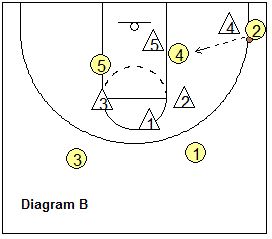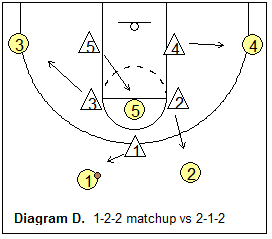1-2-2 Zone Defense
The 1-2-2 zone defense is a tactical approach that focuses on controlling the court through the strategic positioning of players. Unlike man-to-man defense, where players guard specific opponents, zone defense emphasizes guarding specific areas. The formation consists of one player at the front, two players in the middle, and two players in the back. This arrangement aims to disrupt passing lanes, force turnovers, and limit the opponent’s scoring opportunities.
1-2-2 Zone Defense in Basketball
Certainly! The 1-2-2 zone defense is a basketball defensive strategy where players position themselves in a specific formation to guard against the opposing team’s offense. In the 1-2-2 zone defense, there’s one player at the top of the key, two players on the wings, and two players in the low post area. Here’s a breakdown of each player’s responsibilities:
Top Defender (Point Guard or Guard):
The player at the top of the key is responsible for pressuring the ball handler, preventing easy passes into the high post, and disrupting passing lanes. This player’s primary goal is to force the opposition to make difficult decisions and limit their options.
Wing Defenders (Guards or Small Forwards):
The two players positioned on the wings cover the areas along the sidelines. They must challenge outside shots, close out on shooters, and be ready to trap the ball handler if they get caught in a difficult position. These defenders should also be quick to rotate and help in the key areas.
Low Post Defenders (Forwards or Centers):
The two players in the low post are responsible for protecting the paint, contesting shots close to the basket, and grabbing rebounds. They also need to be vigilant about weak-side cuts and ensure that opposing players don’t get open looks under the basket.
Key principles of the 1-2-2 zone defense include:
Communication:
Players must constantly communicate to ensure proper rotations, coverage, and switching. This is crucial to prevent open shots and exploit offensive gaps.
Movement:
Players need to be active and quick in shifting their positions to cover open passing lanes and shots. Rapid movement helps to counter offensive ball movement.
Trapping:
The 1-2-2 zone defense can be effective in trapping the ball handler near the corners or the sidelines. When trapping, the defenders need to work together to force turnovers or limit the offensive player’s options.
Rebounding:
Since there are two players in the low post, they need to be strong rebounders to secure missed shots and prevent second-chance points for the opponents.
Adaptability:
Coaches might choose to tweak the defensive formation based on the opposing team’s strengths and weaknesses. Adjustments could include shifting the focus more toward the perimeter or tightening the interior defense.
Key Principles of the Defense
- Spacing and Movement: Players must maintain proper spacing to cover more ground effectively. Quick movements are essential to close gaps and contest shots.
- Ball Pressure: Applying pressure on the ball handler can force rushed decisions and errant passes, creating chances for steals.
- Communication: Effective communication ensures seamless transitions and helps players anticipate opponents’ actions.
- Rebounding: Despite the zone setup, players must be vigilant about securing rebounds to deny second-chance points.

Setting Up the Formation
To initiate the 1-2-2 zone defense, position players strategically across the court. The player at the front applies pressure on the ball handler, while the two middle players cover passing lanes and potential threats. The players at the back guard against long shots and provide additional defensive support.
Movement and Responsibilities
Players must move cohesively to maintain the integrity of the defense. The front player pressures the ball and prevents easy entry passes, while the middle players shift laterally to guard against mid-range shots and cut off driving lanes. The back players are responsible for contesting outside shots and grabbing rebounds.
Applying Pressure in the Half-Court
One of the strengths of the 1-2-2 zone defense is its ability to apply pressure in the half-court. By limiting space and obstructing passing lanes, the defense can force turnovers and create fast-break opportunities.
Defending Against Outside Shots
Guarding against outside shots is crucial in the 1-2-2 zone defense. The back players must close out on shooters quickly, reducing the likelihood of open images. The front and middle players should communicate effectively to ensure that no shooter is left unattended.
Handling Inside Threats
While effective against outside shots, the 1-2-2 zone defense can be vulnerable to inside threats. Opponents may exploit gaps in the defense for high-percentage shots close to the rim. Communication and quick rotations are essential to counter this challenge.
Transitioning and Fast Breaks
Transitioning from offense to defense and vice versa requires seamless coordination. Players should quickly shift between positions to establish the zone defense before the opponent’s offense takes form. On turnovers, fast breaks can catch opponents off guard, leading to easy baskets.
Adapting to Offensive Strategies
An adaptive defense is a strong defense. Coaches and players must be prepared to adjust the defense based on the opponent’s offensive strategies. This might involve shifting player positions, altering the level of ball pressure, or focusing on specific players.
Effective Communication within the Defense
Communication is the backbone of the 1-2-2 zone defense. Players need to communicate switches, alert teammates about screens, and call out potential threats. A well-informed team can effectively disrupt the opponent’s flow and limit scoring opportunities.

Breaking Down the Weaknesses
Like any defense, the 1-2-2 zone has its weaknesses. Skilled ball movement, sharp outside shooting, and exploiting gaps in the defense can all challenge this formation. Coaches must be aware of these weaknesses and have contingency plans.
Famous Teams Known for Using the 1-2-2 Zone Defense
Over the years, several successful basketball teams have employed the 1-2-2 zone defense as a staple of their strategy. Teams like showcased how effective this defense can be when executed with precision.Also, read about How to Keep the Books for Basketball: A Comprehensive Guide
Step-by-Step Guide to Practice the Defense
- Understanding Assignments: Ensure every player comprehends their role and responsibilities within the defense.
- Drills for Movement: Run exercises that focus on quick lateral movements and proper positioning.
- Ball Pressure Practice: Develop skills in applying controlled pressure on the ball handler.
- Communication Exercises: Practice verbal and non-verbal communication to enhance coordination.
- Live Scenarios: Simulate game situations to help players adapt to real-time challenges.
Common Mistakes to Avoid
- Leaving Gaps: Failing to close gaps in the defense can lead to easy scoring opportunities for the opponent.
- Overcommitting: Players must avoid over-committing to one area, leaving other zones vulnerable.
- Lack of Communication: Poor communication can result in missed assignments and defensive breakdowns.
Mastering the Defense: Tips from the Pros
- Study Opponents: Analyze opponents’ tendencies to anticipate their strategies.
- Quick Rotations: Swift player rotations can close passing lanes and prevent open shots.
- Patience: Avoid gambling for steals and remain patient to avoid mistakes.
Conclusion
The 1-2-2 zone defense offers a dynamic approach to basketball defense, requiring coordination, communication, and adaptability. By mastering this strategy, coaches and players can significantly impact the flow of the game, stifle opponents’ scoring, and create turnovers. Incorporate the principles discussed in this article into your training regimen and elevate your defensive prowess on the court.
Alina is a passionate basketball player with a love for the game that knows no bounds. With years of experience on the court, she brings unmatched skill and dedication to her team. Alina’s commitment to excellence both on and off the court sets her apart as a leader and motivator. Whether she’s driving to the basket or encouraging her teammates, Alina’s enthusiasm and sportsmanship shine through. As a valuable member of the basketball team, Alina’s presence elevates the spirit and performance of the entire squad.







